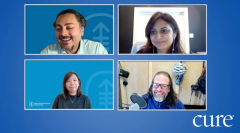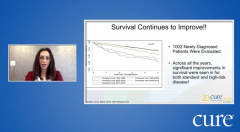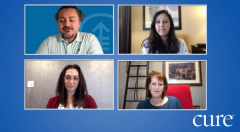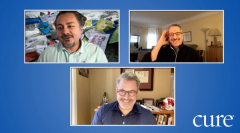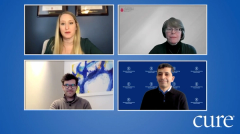
Educated Patient® Multiple Myeloma Summit Relapsed/Refractory Myeloma Presentation: March 12, 2022
Watch Dr. Noa Biran, an associate professor of medicine in the division of multiple myeloma at The John Theurer Cancer Center at Hackensack University Medical Center, discuss treatment for relapsed/refractory myeloma.
Although a diagnosis of relapsed/refractory multiple myeloma can be alarming for patients, families and caregivers, hope continues to grow as more treatment options become available, including combination therapies, to help patients attain long-standing remissions and controlled disease, allowing them to hopefully live a normal life.
“I think it’s important that patients have hope when they’re diagnosed with this illness,” said Dr. Noa Biran, an associate professor of medicine in the division of multiple myeloma at The John Theurer Cancer Center at Hackensack University Medical Center in New Jersey, in an interview with CURE®. “It’s a very scary, life-changing event. They hear the word ‘cancer,’ they think that it’s the end, and it’s not. It’s important to emphasize that multiple myeloma is a chronic disease. It is a disease that is characterized by many relapses and remissions, and that chronic treatment and continuing on treatment can keep the disease in remission for decades.”
Biran discussed treatment advances for patients with relapsed/refractory multiple myeloma during the CURE® Educated Patient® Multiple Myeloma Summit.
FDA-Approved Therapies
There are several therapies approved by the Food and Drug Administration for the
- immunomodulatory drugs (Revlimid [lenalidomide], Thalomid [thalidomide], Pomalyst [pomalidomide]),
- proteasome inhibitors (Velcade [bortezomib], Ninlaro [ixazomib], Kyprolis [carfilzomib]),
- chemotherapy/alkylators (melphalan, bendamustine, cyclophosphamide),
- HDAC inhibitor (Secura [panobinostat]),
- monoclonal antibodies (Darzalex [daratumumab], Empliciti [elotuzumab], Sarclisa [isatuximab]),
- BCMA-directed therapies (Blenrep [belantamab], ide-cel) and
- XPO inhibitors (Xpovio [selinexor]).
Despite the availability of these drugs, Biran noted that treatment decisions should not be made on a one-size-fits-all basis.
“Treatments are really tailored to each individual patient based on their prior response to therapy, their comorbidities, their social situation,” she added. “It’s important to really use your best treatments in the beginning of the disease and not to wait and save them for later.”
Using best treatments up front, including combinations, can be helpful, especially since multiple myeloma is a very heterogenous disease, meaning it can have several root causes, Biran said. For example, one patient can have different tumors, like a lesion in the bone, a lesion in the ribs and a lesion in the clavicle, “In one patient, you can have three different types of multiple myeloma based on the genetics of the disease,” she added.
She emphasized the importance of using multiple agents together to treat multiple myeloma.
“You’re more likely to achieve durable remissions and long-lasting remissions when you combine many agents together,” Biran said. “The best ones you have that are the most potent and effective, the more likely you are to get at all the different clones of the disease and prevent further mutations of the disease and resistance because you don’t want to end up with resistant myeloma that’s going to grow into what we call extramedullary myeloma or disease outside of the bone marrow because then you’re dealing with a very different disease.”
At diagnosis or relapse, some patients worry about whether they’ll be able to continue living their life and manage their disease especially during treatment. Biran said that the side effects of multiple myeloma treatments are almost always manageable, and some people even work through treatment.
“It’s rare to have a side effect where you have to stop the treatment altogether,” Biran said. “One example of that is a type of severe rash that can occur with … lenalidomide or pomalidomide, where there can be a severe rash, and they're allergic to the treatment or a cardiac event or something of that nature. But for the most part, we can reduce, we can hold, we can give treatment breaks. If it's a pill, we'll do one week on, one week off and give a different schedule.”
Approaches to Treating Relapsed/Refractory Multiple Myeloma
Biran added that treating patients with relapsed multiple myeloma is different than those with newly diagnosed disease.
“This is a marathon; it’s not a race in the relapsed setting,” Biran said. “In the newly diagnosed setting, you push through because you want to maybe get to transplant and you want to give a high dose to get the treatment in as much as possible,” Biran explained. “But in the relapsed setting, we're talking chronic, so your goal is not always to get to zero. If you can, great. But if you cannot, it's OK to have some remaining disease as long as the treatment is tolerated, and the person can have an excellent quality of life.”
While treatment is focused on the disease itself, it’s important for patients to focus on their well being during treatment, especially since treatment can take a toll on a patient regardless of its form.
“It’s important to have a different perspective in life, and to try to treasure each and every day,” Biran said. “You have to make sure that every day you’re caring for yourself, … you’re putting yourself first, you’re exercising minimizing steroid-related toxicity to the muscles, minimizing stress and eating healthy overall so you can tolerate the treatment and enjoy your time.”
In addition to self-care, Biran highlighted the importance of
“Find a provider that you trust,” she said. “Have active discussions with your doctor, tell them about side effects, discuss alternatives. Whenever a treatment is offered, it's always a good idea to ask, ‘What are my alternatives? Are there
Biran mentioned that throughout treatment, remissions and other times related to relapsed/refractory multiple myeloma, patients should continue to live their lives.
“Don’t let the disease get in the way of your life,” she said. “I tell my patients this, we're not treating the numbers on the page, the M spike, that's not my goal, it’s you. You're the person and the goal of this is so you can see your grandchildren, you can go on vacation. Treatment, in a way, should be worked around life, not life worked around treatment.”
For more news on cancer updates, research and education, don’t forget to


